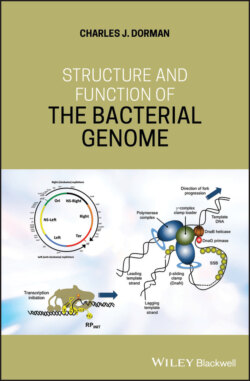Читать книгу Structure and Function of the Bacterial Genome - Charles J. Dorman - Страница 26
1.15 Plasmid Segregation
ОглавлениеPlasmids employ two strategies to ensure segregation of their copies at cell division: active partitioning mechanisms (low copy number plasmids) and reliance on dispersal through the cytosol of the mother cell to ensure that some copies end up in each daughter cell (high copy number plasmids). A third strategy acts post‐segregationally. It is based on toxin–antitoxin systems and eliminates those bacterial cells that do not acquire a plasmid copy at cell division (Hayes 2003) (see also Sections 2.30 and 2.35). The plasmid encodes both a stable toxin and an unstable antitoxin in an operon known as an addiction module: maintenance of the supply of the antitoxin requires the continued presence of the plasmid and the antitoxin‐encoding gene. Bacteria that become liberated from the burden of plasmid‐carriage may outgrow their plasmid‐carrying counterparts. Eliminating the plasmidless bacteria helps to prevent extinction of the plasmid carriers by the fitter, plasmid‐free, segregants. The CcdA/B antitoxin/toxin pair produced by the F plasmid provides an example of this post‐segregational killing strategy. CcdB inhibits DNA gyrase by trapping it in a cleavage complex with DNA, and CcdB activity is neutralised when it binds the unstable CcdA antidote. A bacterium that loses the F plasmid will retain the toxic CcdB molecule after the unstable CcdA molecule has been broken down by the ATP‐dependent Lon protease (van Melderen et al. 1994). The resulting poisoning of DNA gyrase by CcdB kills the plasmidless cell.
High copy number plasmids, i.e. those with 10 or more copies per cell, lack genes that are capable of encoding active partitioning machinery (Million‐Weaver and Camps 2014). Random distribution of the multicopy plasmid through the cytosol seems to account for the faithful inheritance of plasmids such as ColE1 (Durkacz and Sherratt 1983). The formation of plasmid multimers poses a risk because this process reduces the copy number of independently segregating units, but multimer resolution systems such as cer/XerCD in ColE1 provide a potent antidote (Summers and Sherratt 1984). This resolution mechanism is a close relative of the chromosomal dif/XerCD system, albeit with additional co‐factors (Section 1.8). Plasmid distribution in the cytosol is likely to be influenced by the presence of other molecules and structures, not least the nucleoid, and nucleoid exclusion does seem to be a factor in confining plasmids to the space just inside the cytoplasmic membrane (Reyes‐Lamothe et al. 2014; Wang et al. 2016; Yao et al. 2007). The plasmids occur in clusters and frequently these clusters are seen at the poles of the cell; clusters are dynamic, they can divide, with some sub‐clusters relocating to the mid‐cell (Yao et al. 2007). The introduction of another type of plasmid produces an even more complex clustering pattern (Diaz et al. 2015; Yao et al. 2007). It appears that multicopy plasmids move between existing in clusters and being alone, and that these forms diffuse randomly within the confines imposed by the nucleoid and other cell structures (Wang 2017).
Low‐copy number plasmids cannot rely on strategies based on random spatial distribution to ensure their segregation to the daughter cells at division. These plasmids have active partitioning systems, systems that have counterparts in the chromosomes of many bacteria (but not E. coli). These partitioning (Par) systems consist of two proteins, ParA and ParB, and a centromere‐like DNA site called parS (Baxter and Funnell 2014; Gerdes et al. 2010). The ParB protein binds to parS and ParA interacts with ParB, hydrolysing ATP or GTP to provide the energy needed to drive the partitioning process.
Plasmid Par systems, such as those in the single‐copy F plasmid or the P1 prophage plasmid, whose ParA protein has a Walker‐type ATPase motif, use the surface of the nucleoid as a scaffold over which plasmids are actively moved. The mechanism is termed a diffusion‐ratchet, with ParA diffusing over the nucleoid and ParB binding to the parS sequence on the plasmid to form the partition complex (Vecchiarelli et al. 2013, 2014). ParA‐ParB interaction triggers ATP hydrolysis by ParA, denuding the nucleoid surface in the vicinity of the plasmid parS‐ParB complex of active ParA. This depletion effect creates a ParA gradient across the nucleoid surface, moving the parS‐ParB complex (and the plasmid) along the gradient. With two daughter plasmids in play, the effect of ParA depletion and the associated gradients is to move the two plasmids away from each other, segregating them into the two daughter cells. This diffusion ratchet mechanism has replaced earlier hypothetical models of ParA‐ParB‐parS segregation systems that were based on ParA assembly into cytoskeletal filaments (Brooks and Hwang 2017).
The R1 drug‐resistance single‐copy plasmid has a ParMRC partitioning system that consists of a centromere‐like parC site, an adaptor protein ParR that binds to parC and an actin‐like ATPase, ParM. ParM forms filaments that grow bidirectionally, with a ParR‐parC complex one either end. As the filament grows in length, the plasmid copies are separated. ParM searches the cell for ParR‐parC complexes, the complexes stabilise ParM filaments whose dynamic instability requires ATP hydrolysis; the stabilised filaments grow, pushing parC‐containing plasmids to opposite ends of the cell (Garner et al. 2004, 2007). The TubZ‐TubR‐tubZ partitioning system found in many plasmids in Bacillus spp. (e.g. B. thuringiensis) differs from ParMRC in that the TubZ filament grows unidirectionally by recycling TubZ subunits from the leading edge to extend the trailing edge (‘treadmilling’) and uses GTP hydrolysis to form the filament (Fink and Löwe 2015; Larsen et al. 2007).
